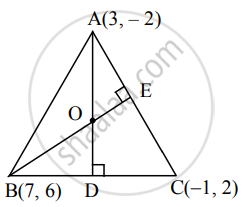Advertisements
Advertisements
Question
Find the co-ordinates of the orthocenter of the triangle whose vertices are A(3, –2), B(7, 6), C(–1, 2).
Solution

Let O be the orthocentre of ΔABC.
Let AD and BE be the altitudes on the sides BC and AC respectively.
Slope of side BC =
∴ Slope of AD = – 2 ...[∵ AD ⊥ BC]
∴ Equation of line AD is
y – (– 2) = (– 2) (x – 3)
∴ y + 2 = – 2x + 6
∴ 2x + y – 4 = 0 .....(i)
Slope of side AC =
∴ Slope of BE = 1 ...[∵ BE ⊥ AC]
∴ Equation of line BE is
y – 6 = 1(x – 7)
∴ y – 6 = x – 7
∴ x = y + 1 .....(ii)
Substituting x = y + 1 in (i), we get
2(y + 1) + y – 4 = 0
∴ 2y + 2 + y – 4 = 0
∴ 3y – 2 = 0
∴ y =
Substituting y =
x =
∴ Co-ordinates of orthocentre, O =
APPEARS IN
RELATED QUESTIONS
Find the slope, X-intercept, Y-intercept of the following line:
2x + 3y – 6 = 0
Find the slope, X-intercept, Y-intercept of the following line:
3x − y − 9 = 0
Find the slope, X-intercept, Y-intercept of the following line:
x + 2y = 0
Write the following equation in ax + by + c = 0 form.
y = 2x – 4
Write the following equation in ax + by + c = 0 form.
Show that lines x − 2y − 7 = 0 and 2x + y + 1 = 0 are perpendicular to each other. Find their point of intersection
Find the equation of the line whose X-intercept is 3 and which is perpendicular to the line 3x − y + 23 = 0.
Find the distance of the point A(−2, 3) from the line 12x − 5y − 13 = 0
Find the distance between parallel lines 4x − 3y + 5 = 0 and 4x − 3y + 7 = 0
Find the distance between parallel lines 9x + 6y − 7 = 0 and 3x + 2y + 6 = 0
Find the equation of the line parallel to the X-axis and passing through the point of intersection of lines x + y − 2 = 0 and 4x + 3y = 10
If A(4, 3), B(0, 0), and C(2, 3) are the vertices of ∆ABC then find the equation of bisector of angle BAC.
D(−1, 8), E(4, −2), F(−5, −3) are midpoints of sides BC, CA and AB of ∆ABC Find equations of sides of ∆ABC
D(−1, 8), E(4, −2), F(−5, −3) are midpoints of sides BC, CA and AB of ∆ABC Find co-ordinates of the circumcenter of ΔABC
Select the correct option from the given alternatives:
If A(1, −2), B(−2, 3) and C(2, −5) are the vertices of ∆ABC, then the equation of the median BE is
Select the correct option from the given alternatives:
The equation of a line, having inclination 120° with positive direction of X−axis, which is at a distance of 3 units from the origin is
Answer the following question:
Find the distance of the origin from the line x = – 2
Answer the following question:
Which of the following lines passes through the origin?
Answer the following question:
Obtain the equation of the line which is parallel to the X−axis and making an intercept of 5 on the Y−axis.
Answer the following question:
Find the equation of the line which passes through the point of intersection of lines x + y + 9 = 0, 2x + 3y + 1 = 0 and which makes X-intercept 1.
Answer the following question:
Find the distance of P(−1, 1) from the line 12(x + 6) = 5(y − 2)
For the lines 5x + 2y = 8 and 5x - 2y = 7, which of the following statement is true?
The length of perpendicular from (1, 3) on line 3x + 4y + 10 = 0, is ______
Let the straight line x = b divide the area enclosed by y = (1 - x)2, y = 0 and x = 0 into two parts R1(0 ≤ x ≤ b) and R2 (b ≤ x ≤ 1) such that
The equation 12x2 + 7xy + ay2 + 13x - y + 3 = 0 represents a pair of perpendicular lines. Then the value of 'a' is ______
The equation 3x2 - 4xy + y2 = 0 represent a pair of straight lines whose slopes differ by ______.
If a plane has x-intercept l, y-intercept m and z-intercept n, and perpendicular distance of plane from the origin is k, then _______.
If the distance of the point (1, 1, 1) from the origin is half its distance from the plane x + y + z + k = 0, then k = ______.
